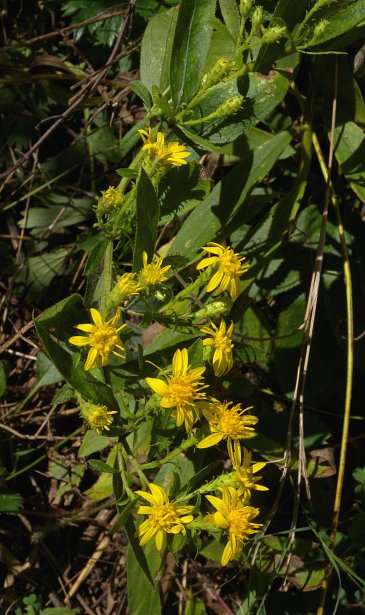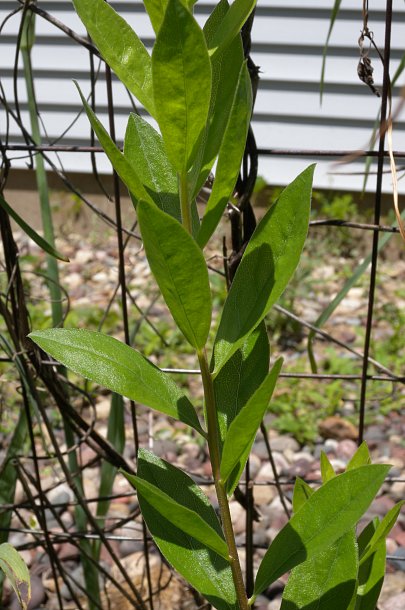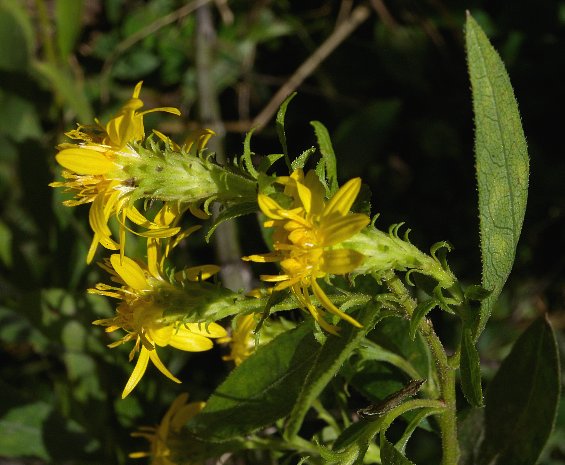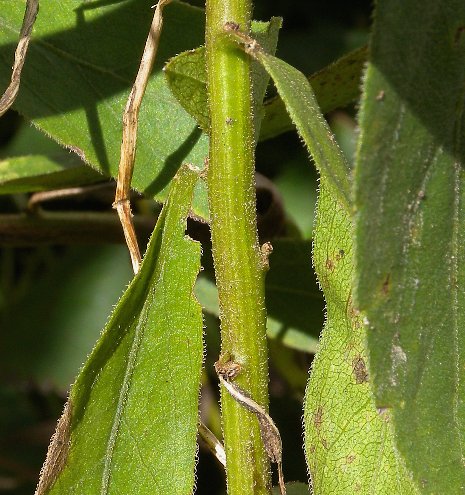
Each flowerhead has 5-10 ray florets that surround a dense head of 8-20 disk florets. The ray florets are pistillate (female), while the disk florets are perfect (both male and female). The spreading petaloid rays of the flowerhead are golden yellow and narrowly oblong in shape. The tubular corollas of the disk florets are yellow and they have 5 narrow lobes along their upper rims. The base of each flowerhead has a cylindrical urn-shape that is tapered at its base; it is surrounded by phyllaries (floral bracts) in about 4 overlapping series. The phyllaries are light green, linear-lanceolate in shape, and either minutely pubescent or glandular-pubescent (usually the latter); these phyllaries are strongly recurved toward their tips. The blooming period occurs from late summer to mid-autumn, lasting about 3-4 weeks. Afterwards, the florets are replaced by achenes with small tufts of hair; they are distributed by the wind. The bodies of these achenes are about 3 mm. long, bullet-shaped, and either glabrous or slightly short-pubescent. The root system is fibrous and sometimes long-rhizomatous; an older plant usually develops a swollen caudex. This plant spreads by reseeding itself or it can form clonal offspring from rhizomes.

Cultivation: The preference is partial sun, mesic to dry conditions, and a somewhat acidic soil containing rocky material or sand. This plant will adapt to cultivation, however it may require staking to prevent it from toppling over.
Range & Habitat: Downy Ragged Goldenrod is native to southern Illinois, where it is uncommon, while elsewhere within the state it is absent (see Distribution Map). Illinois lies along the northern range-limit of this plant; it occurs primarily in south-central and southeast USA. Habitats include upland woodlands, upland savannas, thinly wooded rocky bluffs, thickets, glades with acidic bedrock, and rocky prairies. In the wooded habitats where this plant occurs, they are typically dominated by oaks and hickories. Outside of Illinois, Downy Ragged Goldenrod also occurs in sandy mixed woodlands (where both hardwood deciduous trees and conifers are present). This plant is normally found in high quality natural areas. Occasional wildfires are probably beneficial in maintaining its populations.

Faunal Associations: Very little is known about the floral-faunal relationships of Downy Ragged Goldenrod specifically. This goldenrod is a significant source of nectar for migrating Monarch butterflies in Arkansas (Rudolph et al., 2006) and the larvae of a leaf beetle, Microrhopala excavata, mine its leaves (Clark et al., 2004). For goldenrods (Solidago spp.) in general, the nectar and pollen of the flowerheads attract a wide variety of insects, including honeybees, bumblebees, little carpenter bees (Ceratina spp.), leaf-cutter bees (Megachile spp.), Halictid bees, masked bees (Hylaeus spp.), Andrenid bees, wasps, Syrphid flies and other flies, butterflies, skippers, and beetles. Several Andrenid bees are oligoleges (specialist pollinators) of goldenrods; this includes Andrena hirticincta, Andrena nubecula, Andrena placata, Andrena simplex, and Andrena solidaginis. In addition, a plasterer bee, Colletes simulans armata, is an oligolege of goldenrods. A wide variety of insects feed destructively on the foliage, flowerheads, stems, roots, and plant juices of various goldenrods. These species include leaf beetles (Microrhopala spp., Ophraella spp., Trirhabda spp.), larvae of leaf-miner flies (Calycomyza spp.), larvae of gall flies (Asteromyia spp., Rhopalomyia spp.), plant bugs (Lygus spp., Polymerus spp., Slaterocoris spp.), Corythucha marmorata (Goldenrod Lace Bug), aphids (Uroleucon spp.), treehoppers (Stictocephala spp.), Aonidomytilus solidaginis (Goldenrod Scale), larvae of Gelechiid moths (Dichomeris spp.), larvae of Schinia nundina (Goldenrod Flower Moth) and other Noctuid moths, larvae of Tortricid moths (Epiblema spp., Eucosma spp., Phaneta spp.), and grasshoppers (Melanoplus spp.); see Clark et al. (2004), Spencer & Steyskal (1986), Felt (1917), Aldrich & Osten-Sacken (1905), Knight (1941), Watson (1928), Wheeler et al. (1983), Cranshaw (2004), Hottes & Frison (1931), Blackman & Eastop (2013), Dennis (1952), Covell (1984/2005), Miller (1987), and Vickery & Kevan (1985) for more information. Vertebrate animals use goldenrods as a source of food to a more limited extent. The seeds of these plants are eaten by such birds as the Indigo Bunting, American Goldfinch, Slate-colored Junco, and Tree Sparrow; the Greater Prairie Chicken feeds on the foliage and flowerheads (DeVore et al., 2004; Martin et al., 1951/1961; Yeatter, 1943). Occasionally, the White-tailed Deer and Cottontail Rabbit also feed on the young foliage of goldenrods (Sotala & Kirkpatrick, 1973; Martin et al., 1951/1961). These plants are a source of food for the Prairie Vole (Cole & Batzli, 1979) and probably other voles.

Photographic Location: The wildflower garden of the webmaster in Urbana, Illinois.
Comments: Sometimes this species is called 'Downy Goldenrod.' There is some variability in the width of leaves, presence of teeth on the leaves, abundance of pubescence, and presence of glandular hairs on this goldenrod across its range. Downy Ragged Goldenrod (Solidago petiolaris) is easy to identify in Illinois because of the recurved phyllaries (floral bracts) of its flowerheads; this is the only goldenrod within the state that has this characteristic, and it is rare among goldenrods (Solidago spp.) elsewhere. One species with this characteristic is Stout Goldenrod (Solidago squarrosa). This latter species is found primarily in northeastern United States. Stout Goldenrod has larger lower leaves than Downy Ragged Goldenrod (Solidago petiolaris), and its lower leaves have more teeth. Overall, it is a less hairy plant than Downy Ragged Goldenrod. The remaining goldenrod with recurved phyllaries, Wright's Goldenrod (Solidago wrightii), is difficult to distinguish from Downy Ragged Goldenrod. Because Wright's Goldenrod occurs some distance away in the southwestern area of the United States, it won't be considered any further.